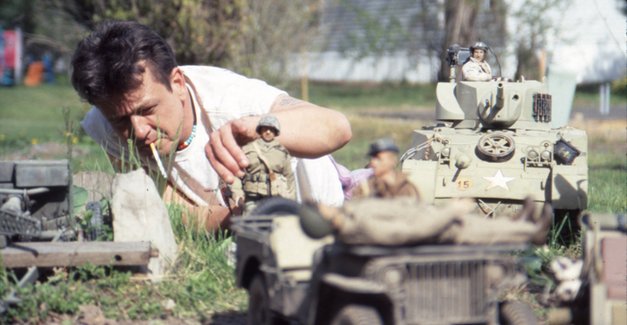The camera in Jeff Malmberg’s documentary “Marwencol” is always stationary, but it’s handheld and shaky, just like the flimsy action figures composing Mark Hogancamp’s fantasy world. They don’t move, but they have life and immense depth, and there’s still so much that seems unclear about them.
The film is named for the make believe town Hogancamp has created in his home and backyard in which he uses GI Joes and Barbie dolls to enact a sweeping World War II epic set in Belgium. He lives out alter egos for himself and his family and friends in Marwencol, and he photographs different moments in their lives in vivid detail.
Except Hogancamp is already living an alter ego. After being beaten senseless by a group of five teenagers leaving a bar, Hogancamp suffered severe brain damage and woke from a coma as a new person, with no recollection of his ex-wife, his hobbies, personality or how he suffered from alcoholism. His new way to keep his mind stimulated is through models in his parents’ hobby shop, but it evolved beyond something to pass the time into literally a second existence he takes as seriously as anything.
Hogancamp’s story is a remarkable one, especially when you finally get a glimpse of his grippingly lifelike photography. His life and his work deserve a film, although comparatively, probably no one would make a completely sympathetic story about a person obsessively playing a role playing game on Facebook.
Malmberg shows us all we would care to know about Marwencol and how this town operates. The Barbies have catfights nightly in the bar, but they’re all staged and no one gets hurt. The toy trucks are all dragged miles down the highway to give the new, out of the box wheels the appropriately rugged look. Certain chapters of Marwencol’s tale are especially bleak and bloody because Hogancamp is subconsciously re-enacting memories of his brutal attack.
We know there are a lot of rules in Marwencol, but what we never really learn is why Hogancamp plays out certain specifics in his second life. Why set the story in Belgium with SS Officers and a blue-haired witch who can travel through time? What does this particular story say about him? I’ll take for granted Malmberg asked these questions of Hogancamp without much of an answer, but the whole film still feels ambiguous.
An art critic for a magazine notes that with Hogancamp, nothing he photographs has any hint of irony or cynicism the way it does with other artists taking pictures of dolls and inanimate objects. The film seems to lack that nuance too. It hints at some of Hogancamp’s more peculiar behavior in public, and it never addresses whether any of this is healthy for him. There may be something troubling going on when Hogancamp begins creating a fake world within Marwencol, but the film doesn’t say and the testimonial interviews add nothing but pleasant words.
The film demands these questions most of all when Hogancamp’s photography is selected for an arty gallery space in Greenwich Village, only to be admired, debated and mocked as he awkwardly mingles in the crowd. Other reviews have pointed out that “Marwencol” is intriguing in the way it brings up questions of what defines art, but that point strikes me as moot because Hogancamp never identifies himself as an artist.
His work is an extension of his psyche, and maybe that’s precisely what most artists do when they work, but Hogancamp says outright that he’s not a photographer and that this for him is his unique form of therapy. If people were to invade his world, it would stop being his therapy and soon belong to everyone, thus his apprehension at showing his work to society.
For this very reason, “Marwencol” keeps its distance. It doesn’t resonate deeply because this is not our therapy, our story or our film; it’s his.
3 stars
For more of Mark Hogancamp’s remarkable work in Marwencol, view his website with all of his photos here.



1 thought on “Marwencol”